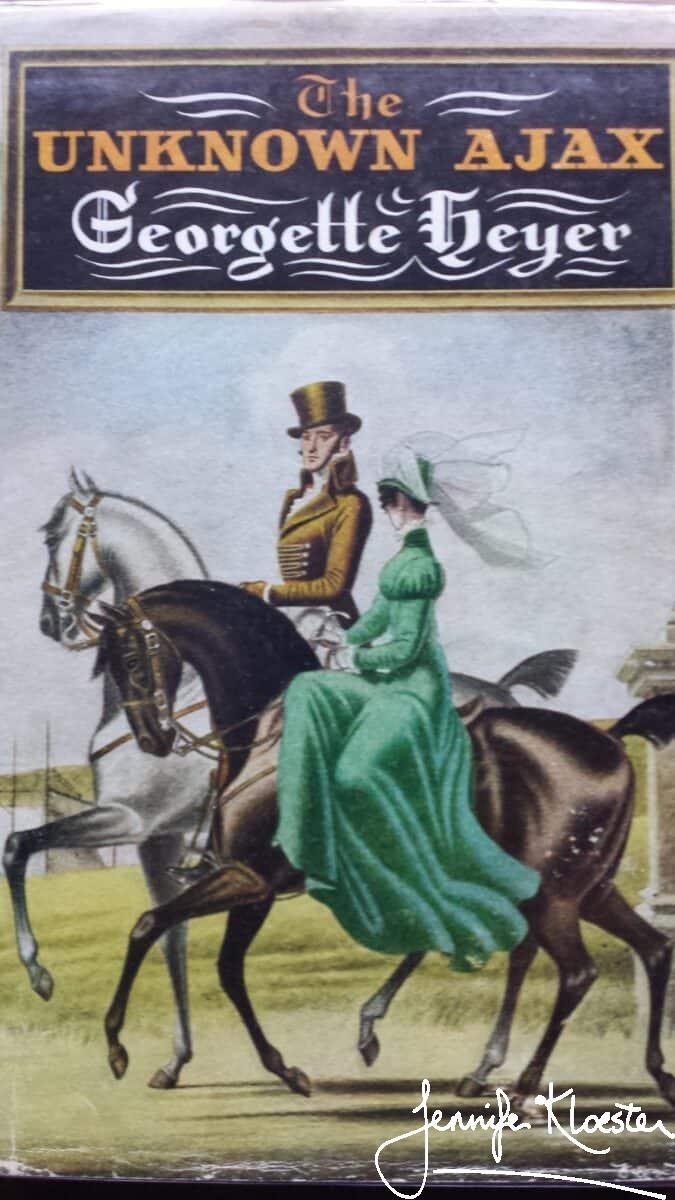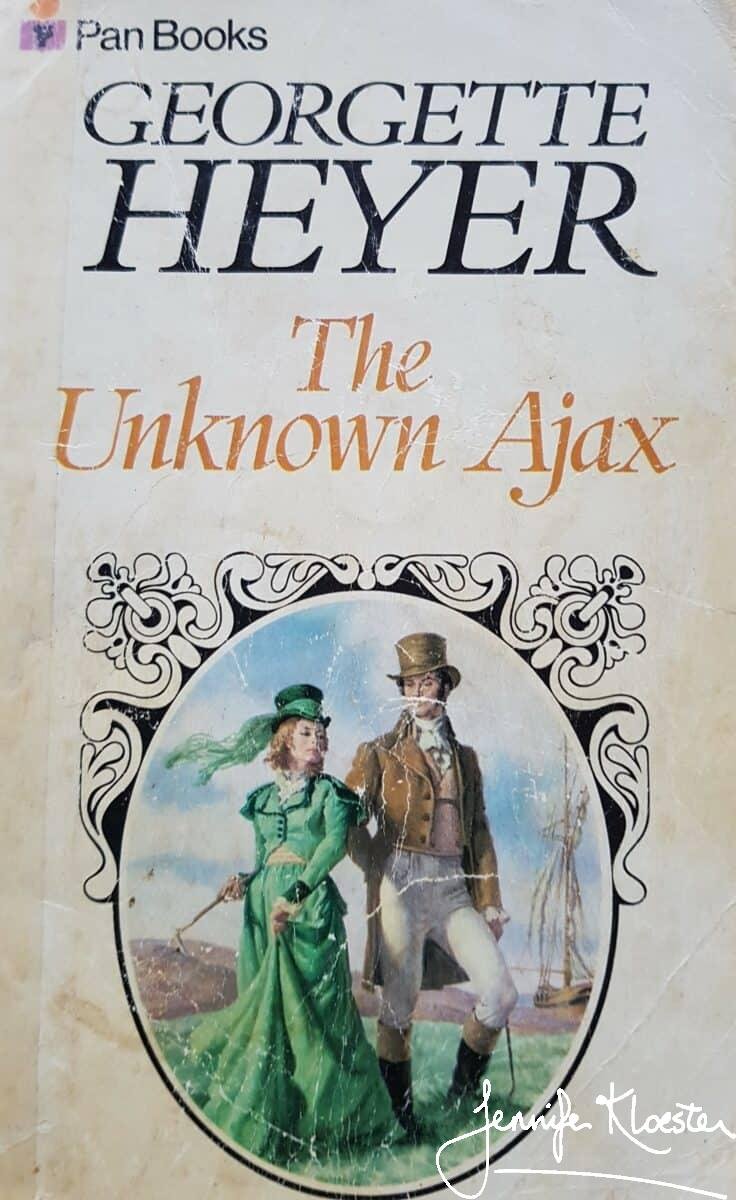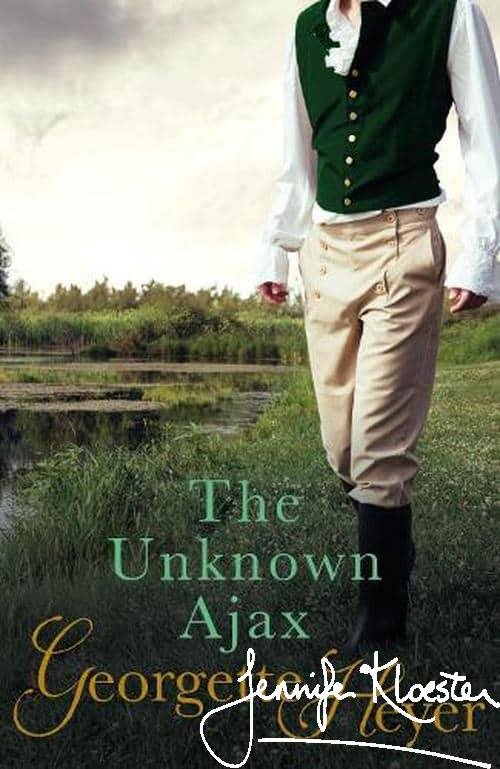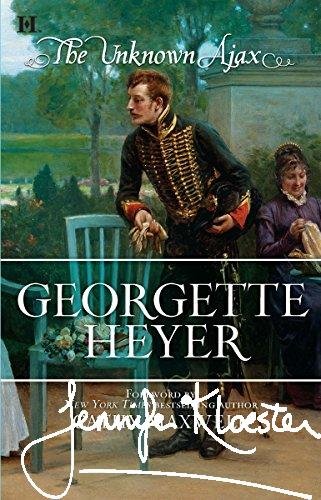‘I was much wrapt in this;
Shakespeare, Troilus and Cressida, Act 3 Scene III
And apprehended here immediately
The unknown Ajax.
Heavens, what a man is there! a very horse, that has he knows not what.’

An entirely new novel
In May 1958, Georgette Heyer went on holiday to Rye on the English south coast. She had been to Rye before and loved the historic town with its cobbled streets and ancient houses and was looking forward to another visit – this time with an entirely new novel in mind. Georgette’s husband, Ronald, and her son, Richard, were to play in the annual Bar Golf Tournament over Whitsun and she had decided to spend her time (when not watching her menfolk golf) collecting material for her new story. They were to put up for a week at the New Lion Inn in Winchelsea, just two miles from Rye, and Georgette told her friend and publisher, A.S. Frere:
‘I have had an idea for another book, & think Rye would be an excellent setting, so I shall have a lovely week, fossicking around for smugglers’ haunts, & what-have-you.’
Georgette Heyer to A.S. Frere, letter, 17 May 1958


Mermaid Street, Rye, inspired Georgette when writing The Unknown Ajax. 
As did the stories about the notorious Hawkhurst Gang
If you wake at midnight, and hear a horse’s feet,
‘A Smuggler’s Song’, Rudyard Kipling – Georgette and Ronald both read and admired Rudyard Kipling
Don’t go drawing back the blind, or looking in the street.
Them that ask no questions isn’t told a lie.
Watch the wall, my darling, while the Gentlemen go by!
Georgette was right
Georgette was right about the setting, for Rye’s history was a colourful one with plenty of meat for the bones of her story. The novel, though mostly set in the huge rambling manor house of Darracott Place on the edge of Romney Marsh, has several enlivening scenes in Rye. By now, Georgette was thoroughly adept at distilling historical information into her story and she obviously enjoyed having her hero visit Mermaid Street and Ypres Tower while his cousin Claud regaled him with stories of smugglers, murder, and a body in an iron cage. Smugglers were to perform an important role in the story and Georgette did her usual through research, acquainting herself with the history of the Hawkhurst gang and the role of the Land Guard in trying to curb the “Gentlemen” and their illicit trade. As always, her characterisation was superb and even her most minor players are brought to life as fully-fleshed, living, breathing characters (okay, not the skeleton!). This is a novel replete with memorable scenes and some of Heyer’s funniest dialogue. It is also rich in dialect and Heyer’s use of the broad Yorkshire spoken by her huge hero and which so thoroughly deceives his incredulous family is superbly rendered.

The famous Ypres tower near the breach in the town wall. It was near here that Hugo fell into conversation with Lieutenant Ottershaw. 
A skeleton in a gibbet inside the Ypres Tower. Claud Darracott entertained his cousin Hugo with tales of Tye’s history.
A magnificent deception
The Unknown Ajax, is one (among several) of Georgette Heyer’s most original and clever creations. Among other things it is a book about deception and how one magnificent deception in the end saves a family from scandal and disgrace. Hugo Darracott, recently returned from the Napoleonic wars, is the reluctant and unexpected heir to his tyrannical old grandfather, Lord Darracott. His grandfather has never acknowledged Hugo as his kin, having ruthlessly cut off Hugo’s father after he had had the temerity to marry a weaver’s daughter. Now that his heir, Granville, and his heir’s son are dead, Lord Darracott has commanded his unknown grandson, Hugo, to present himself at his ancestral home – Darracott Place in Sussex. It is the old gentleman’s intention to lick the new heir ‘into shape’. Hugo arrives on horseback bespattered with mud and is confronted by his family – all of them unknown to him and most of them hostile to his presence. This deceptively gentle giant with his deceptively meek demeanour, instantly perceives his new family’s unflattering attitude towards him but does nothing to discourage their mistake – quite the opposite, in fact!

Masterful plotting
It is not only Hugo who engages in deception, however, for young Richmond Darracott, thwarted in his ambition to join the military, has secrets of his own. The plotting is masterful and a reflection of Heyer’s skill as a writer. Each character has their own individual journey of discovery – discovering things about themselves as well as about those around them. Each character follows a fully-realized character arc so that, by the end of the novel, every one but Hugo (who is already an ideal) and Lady Aurelia (who is highly-principled and unusually perceptive) has changed. This is particularly true of the difficult characters – those such as Lord Darracott, Vincent and Matthew, each of whom is blind to his personal flaws and who must each discover the truth about himself and those he has misjudged. The genius of Heyer’s plotting in The Unknown Ajax may not be fully apparent on a first or even a second reading, but as with others of her books, a close perusal of the novel (the audio book is particularly useful in this regard) is very revealing.

“He’s a new one, too, which makes an epoch!”
Despite having begun her research for The Unknown Ajax in May of 1958, it would be almost another year before Georgette began writing the projected novel. On April 6 1959, she wrote to Frere to tell him that, ‘I’ve done about 20,000 words to date. No idea what it’s like.’ Never one to admit that her work was good – at least not while in the process of writing a particular novel – Georgette would later describe The Unknown Ajax as ‘one of those I do think good’. She was proud of the book and especially pleased that, despite being her forty-seventh novel and her eighteenth Regency, it was truly a new plot and hero. As she explained to Frere:
We are just back from 9 days at Deal, over Whitsun. The usual Brunch & Bar Golf Tournament. Weather generally foul, & very cold, but it saved me from total collapse. I was in a very odd state when I left town, & did nothing but sleep for several days! I took Ajax with me, meaning to finish him in longhand, but I only wrote half a chapter. Great display of tact and restraint on the part of G.R. Rougier, Q.C. who made no attempt to persuade me to leave Ajax behind, but managed to think up grand reasons why I shouldn’t do a stroke of work! I may add that The Finch sent tender messages to me not on any account to bother about! This morning I received the enclosed from her, which you may like to have. I’m glad she likes Hugo, I think she really does, & I rather like him myself. He’s a new one, too, which makes an epoch! I expect to finish the job by the end of the week.
Georgette Heyer to A.S. Frere, letter, 27 May 1959.

Heyer’s Understanding
It is a very entertaining novel, but it is also one which reveals Heyer’s understanding of the Regency era to which her name would become so firmly linked. In The Unknown Ajax she proves particularly adept at revealing the plight of women in the Regency and their all-too-often miserable dependence upon men. Old Lord Darracott, a dictatorial man used to having his orders instantly obeyed, believes his grandson to be low-born and vulgar and has decided that the best way to keep him in his place is to have him marry his granddaughter, Anthea. Anthea is appalled by the decree, telling her mother that her grandfather is a ‘medieval bedlamite’. While Anthea is no weak-willed female, but a strong-minded young woman who resents her dependence upon her mean-spirited grandsire, her mother is all-too alive to the realities of their situation. She begs her daughter not to risk alienating Lord Darracott, for she knows all to well that they are completely dependent upon him for their survival. This was the harsh reality for most women during the Regency era and it is a reality which Heyer uses to great effect in her novels. She understood the constraints of the time and they play a vital role in her Regency stories.

‘Ajax renown’d. O heavens, what some men do,
Shakespeare, Troilus and Cressida Act 3 Scene III
While some men leave to do!
How some men creep in skittish fortune’s hall,
Whiles others play the idiots in her eyes!
How one man eats into another’s pride,
While pride is fasting in his wantonness!
To see these Grecian lords!?why, even already
They clap the lubber Ajax on the shoulder,
As if his foot were on brave Hector’s breast
And great Troy shrieking.’
Shakespeare – an inspiration
In writing The Unknown Ajax Georgette was also inspired by Shakespeare. In particular, his difficult play, Troilus and Cressida. She had been raised on a rich diet of Shakespeare, among other classic writers, and took genuine pleasure in including, when apposite, Shakespearean quotations in her novels. The character of Ajax as rendered by Homer in The Iliad is that of a man of huge stature and great physical strength. He is a Greek warrior and one who fights with Achilles. In Shakespeare’s play, however, Ajax, though of large stature and impressive build is not the brightest among the Greeks in Troy. It is this persona which the Darracotts assume to be Hugo’s and which gives Vincent so many opportunities to quote disparagingly from the play. ‘The lubber Ajax’ and ‘the elephant Ajax’ are but two of the Shakespearean appellations applied to Hugo. He takes it all in good part, however, and as Jane Aiken Hodge so rightly says, he ‘sweeps into the book, like a great gale of fresh air, with is irresistible healing sense of humour, and his gift of love. There is so much to this novel than may be seen at first glance!
‘How now, Thersites! what lost in the labyrinth of
Shakespeare, Troilus and Cressida, Act 2 Scene III
thy fury! Shall the elephant Ajax carry it thus? ‘
“it’s noan so bad”
Incredibly, Georgette finished writing The Unknown Ajax in just over two months! As always, she refused to acknowledge the achievement, but wrote to Frere to say humorously:
Sithee, love, (as my hero would say) it’s noan so bad! I have just rushed through, correcting, & transcribing corrections; & I don’t know, but I think it’ll do.’
Georgette Heyer to A.S Frere, letter, 13 June 1959.
But Georgette Heyer had achieved more than she cared to admit. The truth is that The Unknown Ajax is a remarkable book and one of Heyer’s best, if only for the sheer brilliance of its ending. This is one of those novels about which that a reader need only mention a character or a line of dialogue to inspire laughter. It ending is famous among Heyer readers and should be listed among the classics of literature. It is masterfully constructed and perfectly executed and includes these unforgettable lines regarding the redoubtable and unforgettable Lady Aurelia:
‘As a mere female, I cannot consider myself competent to deal with such an affair’ …
The Major, a phlegmatic man, was the first to recover from the shattering effect of this encounter with a mere female, and he acted with great promptitude an good sense, saying meekly, “Yes, ma’am”.
Lady Aurelia Darracott in Georgette Heyer, The Unknown Ajax, Pan, 1972, pp.308-9
‘She then turned, and looked round the room, with all the lofty contempt natural to the descendant of eleven Earls, all of whom, if not otherwise distinguished, had been remarkable for the high-handed and very successful way with which they had dealt with inferior persons and overridden all opposition to their domestic decrees. No one saw these august personages range themselves at Lady Aurelia’s back, but (as her appreciative elder son afterwards asserted) no on could doubt that they had all of them hurried to the support of so worthy a daughter.’
Georgette Heyer, The Unknown Ajax, Pan, 1972, p.307
Read, reread and enjoy The Unknown Ajax. There are multiple print editions, there is the superb audio book read by Daniel Philpott and the equally superb new Penguin audiobook read by Thomas Judd.
‘No, noble Ajax; you are as strong, as valiant, as
Shakespeare, Troilus and Cressida Act 2 scene III
wise, no less noble, much more gentle, and altogether
more tractable.’




